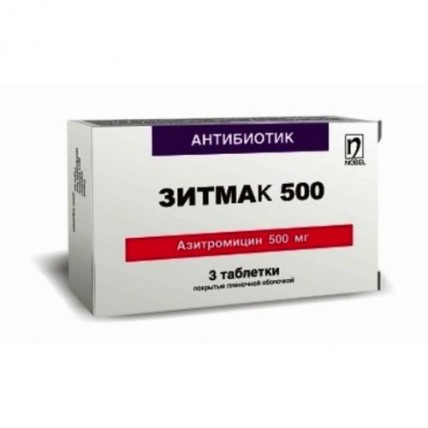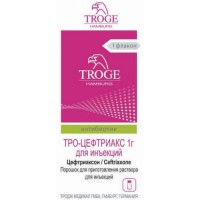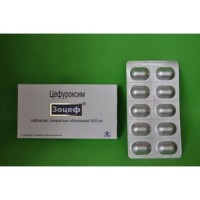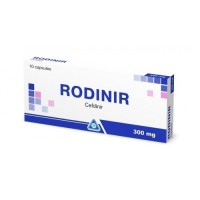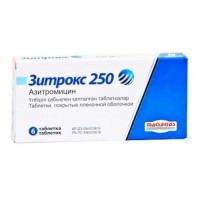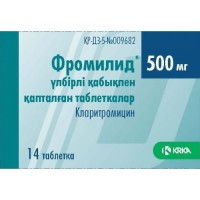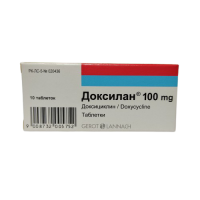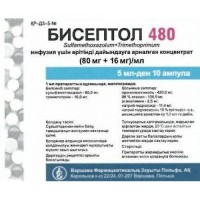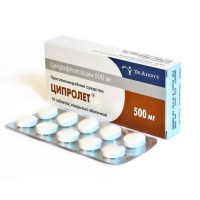Zitmak 3's 500 mg film-coated tablets
- $22.90
The instruction for medical use
of Зитмак® 500 medicine
the Trade name
Зитмак® 500
International unlicensed
names Azithromycin Dosage Form
of the Tablet, film coated, 500 mg
Structure
One tablet contains
active agent - azithromycin a dihydrate of 524.0 mg 500 mg of azithromycin,
excipients are equivalent: prezhelatinizirovanny starch, hydrosipropiltsellyuloza of L-HPC 21, sodium lauryl sulfate, sodium of a kroskarmelloz, calcium hydrophosphate dihydrate, silicon dioxide colloidal anhydrous (Aerosil 200), lactose anhydrous, magnesium stearate,
structure of a cover of Sepifilm 752 Blanc: a hydroksipropilmetiltsellyuloza, cellulose microcrystalline, the titan dioxide (E 171), a macrogoal – 40 OE stearate.
The description
of the Tablet, film coated white color, oblong shape and with risky on one party.
Pharmacotherapeutic group
Antibacterial drugs for system use. Macroleads, linkozamida and streptogramina. Macroleads. Azithromycin.
The ATX J01FA10 code
the Pharmacological
Pharmacokinetics Azithromycin properties is quickly soaked up from digestive tract and widely distributed on all organism. Higher concentration of azithromycin in fabrics, than in plasma or serum is caused by its property of fast distribution. At reception of a single dose of 500 mg inside the maximum concentration makes 0.5 mkg/ml and is reached within 2.5 - 3 hours (= Tmax). The seeming constant volume of distribution (Vd) is about 31.1 l/kg. Elimination half-life makes 14-72 hours. The prolonged final elimination half-life is caused by big accumulation and the subsequent removal of drug from fabrics. Removal of azithromycin with bile, mainly in not changed look, is the main way of elimination. At use over a week, about 6% of the accepted dose are removed with urine in not changed look. At use of the mode of treatment of 500 mg in the first day and 250 mg daily within 4 days in cerebrospinal fluid only very low concentration (less than 0.01 mkg/ml) were found.
The pharmacodynamics
Azithromycin is derivative erythromycin and belongs to ozalid group of a subclass of makrolidny antibiotics. Azithromycin works by means of linking with a ribosome subunit 50S at sensitive microorganisms and, thereby, interferes with protein synthesis of microorganisms. Does not influence synthesis of nucleic acids.
In comparison with erythromycin azithromycin is more active concerning gram-negative microorganisms, is steadier in acidic environment of a stomach, is more slowly removed from an organism and works more for a long time, is better transferred, to a lesser extent inhibits liver R-450 cytochrome.
ǿԼᬮ 500 possesses a wide range of antimicrobic action. It is effective concerning many strains below the listed microorganisms as in vitro, and in clinically apparent infections:
Chlamydia pneumonia, Chlamydia trachomatis, Mycoplasma pneumonia, Borrelia burgdorferi, Mycoplasma pneumonia, Treponema pallidum, Ureaplasma urealyticum.
Aerobic gram-positive microorganisms
of Staphylococcus aureus, Streptococcus agalactiae, Streptococcus pneumonia, Streptococcus pyogenes, streptococci (C, F groups, G), Viridans group streptococci.
Aerobic gram-negative microorganisms
of Haemophilus influenzae, Moraxella catarrhalis, Bordatella pertussis, Campylobacter jejuni, Legionella pneumophila.
Anaerobic microorganisms
of Bacteroides bivius, Clostridium perfringes, types of Peptostreptococcus.
Cross azithromycin resistance about erythromycin - resistant gram-positive strains was noted. The majority of strains of Enterococcus faecalis and Methicillinum - resistant staphylococcus are resistant to azithromycin.
Indications
- pharyngitis, tonsillitis, sinusitis, average otitis
- acute and chronic bronchitis, interstitial and alveolar
pneumonia
- the chronic migrating erythema
- an initial stage of a disease of Lyme, an ugly face, impetigo, secondary
pyodermatoses
- the diseases of a stomach and a duodenum associated with
Helicobacter pylori
- a gonorrheal and not gonorrheal urethritis and/or a cervicitis
ЗИТМАК® 500 accept the Route of administration and doses in 1 hour prior to food or in 2 hours after a meal once a day.
Adults (including patients of advanced age) and children are more senior than 12 years with body weight more than 45 kg:
In infections of upper and lower parts of airways, infections of skin and soft tissues appoint on 500 mg/days within 3 days (a course dose – 1.5 g).
At the migrating erythema drug is appointed by 1 times/days within 5 days: in the 1st day - 1 g, then with 2 on the 5th days - on 500 mg, a course dose - 3 g.
In Lyme's disease (borellioza) for treatment of an initial stage (erythema migrans) appoint 1 g (2 tablets) in the first day and on 500 mg (1 tablet) daily from the 2nd to the 5th day (a course dose – 3 g).
In the diseases of a stomach and duodenum associated with Helicobacter pylori ЗИТМАК® 500 appoint 1 g (2 tablets) a day within 3 days as a part of combination therapy.
In an uncomplicated urethritis and/or a cervicitis appoint once 1 g (2 tablets on 500 mg).
In case of the admission of reception of one dose of drug it is necessary to accept the passed dose as soon as possible, and the subsequent – with breaks at 24 o'clock.
Side effects
Often (& gt, 1/100, & lt, 1/10)
- nausea, vomiting, diarrhea, an abdominal pain
Infrequently (& gt, 1/1000, & lt, 1/100)
- a liquid chair, a meteorism, a digestive disturbance, loss of appetite
Seldom (& gt, 1/1000, & lt, 1/100)
- a headache, dizziness, drowsiness, spasms, a dysgeusia
- thrombocytopenia
- aggression, excitement, concern, nervousness, insomnia
- paresthesias, an asthenia
- a hearing disorder, deafness and sonitus
- tachycardia, arrhythmia with ventricular tachycardia, lengthening of an interval of QT, arrhythmia of type of trembling/blinking (torsades de pointes)
- discoloration of language, a constipation, pseudomembranous colitis
- tranzitorny rise in level of aminotransferases of a liver, bilirubin,
cholestatic jaundice, hepatitis, pancreatitis, a peloric stenosis
- reactions of hypersensitivity: reddening, skin rash, an itching, a small tortoiseshell, a Quincke's disease, photosensitivity, a multiformny erythema, Stephens-Johnson's syndrome, a toxic epidermal necrolysis
- an arthralgia
Very seldom (& gt, 1/10000, & lt, 1/1000)
- interstitial nephrite, an acute renal failure
- fatigue, convulsions
- change of taste and sense of smell
- a vaginitis, candidiasis, superinfections
- an acute anaphylaxis, including hypostasis (in rare instances leading to death)
Makrolidny antibiotics can cause pathological changes in electric activity of heart that can extend an interval of QT and to serve as the cause of cardiac arrhythmia of type of trembling/blinking (torsades de pointes).
At the patients accepting azithromycin the risk of lengthening of an interval of QT and potentially fatal torsades de pointes is increased. At the persons which had arrhythmia in the anamnesis against the background of treatment by azithromycin arrhythmia as trembling/blinking and the subsequent myocardial infarction can develop.
Contraindications
- hypersensitivity to azithromycin, erythromycin or any
antibiotic from group of macroleads
- heavy abnormal liver functions, and kidneys
- cholestatic jaundice, a liver disfuntion against the background of intake of azithromycin in the anamnesis
- a severe form of cardiovascular insufficiency
- the I trimester of pregnancy, the lactation period
- children's age up to 12 years with body weight less than 45 kg
With care at: arrhythmias (development of piruetny ventricular tachycardia).
Medicinal interactions
At simultaneous use Зитмак® 500 with:
- the antacids containing hydroxide of aluminum and magnesium: concentration of drug
- Cimetidinum decreases: Cimetidinum use (800 mg) in two hours prior to intake of azithromycin does not influence absorption of the last
- theophylline: in therapeutic doses azithromycin moderately affects theophylline pharmacokinetics (intravenous and peroral)
- warfarin: azithromycin does not influence a prothrombin time at use of a single dose of warfarin. However use in medical practice provides attentive observation of a prothrombin time at all patients receiving simultaneous treatment by azithromycin and warfarin
- digoxin: azithromycin leads to increase in concentration of digoxin
- ergotamine or dihydroergotamine: there can be acute intoxication ergotaminovy drugs which is characterized by a peripheral vasospasm and a dizesteziya (disturbance of sensitivity)
- tetracyclines and chloramphenicol: strengthen action (synergism)
- linkozamidam: lower effect of drug
- ethanol, food: slow down and lower absorption
- Cycloserinum, indirect anticoagulants, Methylprednisolonum and felodipiny: azithromycin slows down excretion, increases concentration in blood serum and enhances toxicity
- carbamazepine, valproic acid, hexobarbital, Phenytoinum, Disopyramidum, Bromocriptinum, theophylline and other ksantinovy derivatives, oral hypoglycemic means: azithromycin, inhibiting microsomal oxidation in hepatocytes, extends elimination half-life, slows down excretion, increases concentration and toxicity.
Zidovudine: azithromycin increases concentration of an active fosforilirovanny metabolite of a zidovudine in blood. However now the clinical importance of this pharmacokinetic interaction is not clear.
Rifabutin: combined use of azithromycin and a rifabutin did not change their plasma concentration. However at the same time the neutropenia was observed, relationship of cause and effect between development of side reaction and use of this combination is not established.
Special instructions
It is necessary to observe a break of 2 h at simultaneous use of antacids and drug Зитмак® 500.
At the patients receiving treatment by azithromycin serious allergic reactions, including a Quincke's disease, an anaphylaxis and dermatological reactions, such as Stephens-Johnson's syndrome and toxic epidermal necrolysis which can become fatal were in rare instances observed. At emergence of allergic reaction, azithromycin needs to be cancelled immediately and to begin the corresponding therapy. However symptoms of an allergy can appear again, at the termination of symptomatic therapy.
At treatment of pneumonia it was noted that azithromycin is safe and effective at treatment of the community-acquired pneumonia caused by Chlamydia pneumonia, Haemophilus influenzae, Mycoplasma pneumonia or Streptococcus pneumonia in patients suitable for oral therapy. Azithromycin should not be applied at patients with pneumonia to whom oral therapy is inexpedient proceeding from weight of pneumonia, that is at average or heavy severity or if is available some of the listed risk factors:
- patients with cystous fibrosis
- patients with intrahospital infections
- patients with suspicion or the revealed bacteremia
- the patients needing hospitalization
- the elderly or weakened patients, in a condition of the expressed immunodeficiency and a functional aspleniya.
About cases of pseudomembranous colitis from easy to life-threatening degree it is reported at use of almost all antibacterial agents including azithromycin. In the diarrhea which followed after intake of antibacterial agent, all suspected antibiotics need to be cancelled with co-administration of means for elimination of dehydration and correction of water and electrolytic balance. It is necessary to appoint the causal treatment directed to destruction of Page.difficile in intestines and, if necessary, to consider the indication for surgical treatment.
Because azithromycin, mainly, is removed through a liver, it is necessary to be careful at use of azithromycin for patients with insufficiency of functions of a liver. At emergence of signs and symptoms of hepatitis the intake of azithromycin has to be stopped immediately as it was reported about cases of an abnormal liver function, development of hepatitis, cholestatic jaundice, necrosis of a liver and a liver failure, including with a fatal outcome.
Owing to insufficient data at persons who have a glomerular filtration rate & lt, 10 ml/min. it is necessary to be careful when prescribing azithromycin.
As usual at any kind of antibacterial therapy, it is reasonable to examine the patient to define the consecutive infection having not bacterial origin including fungi.
With care it is appointed the patient with cardiovascular pathology. Administration of drug can provoke an arrhythmia attack (ventricular arrhythmias and lengthening of an interval of QT are possible), sudden cardiac arrest. It is necessary to appoint with care drug to patients with the inborn or acquired prolongation of an interval of QT, with disturbances of electrolytic balance, especially in the presence of a hypopotassemia and a hypomagnesiemia, with patholologically rare heart rate and also to the patients taking the antiarrhythmic drugs. The patients receiving azithromycin can have an aggravation of symptoms of a myasthenia (myasthenia gravis) or the new beginning of a myasthenic syndrome. Duration of use of drug should not exceed the terms specified in the instruction.
Drug contains lactose therefore it is not recommended to be applied the patient with intolerance of a galactose, insufficiency of Lappa lactase or disturbance of digestion of glucose galactose.
Use in pediatrics
to Children from 6 to 12 years is recommended to apply a children's dosage form ЗИТМАК® 125, the tablets film coated according to the instruction.
Children up to 6 years are not recommended to apply a dosage form in the form of tablets, and it is recommended to apply ЗИТМАК® 100 and ЗИТМАК® 200 suspension, powder to preparation of suspension for intake of 100 mg / 5 ml and 200 mg / 5 ml complete with the water purified according to the instruction.
Use for elderly patients
patients of advanced age have no need for correction of a dose with normal function of kidneys and a liver.
Pregnancy and the period of a lactation
Use of drug in the second and third trimesters of pregnancy is possible when the expected advantage exceeds potential risk for a fruit.
In need of use of drug in the period of a lactation the breastfeeding should be suspended.
Features of influence of medicine on ability to run motor transport or moving mechanisms
Considering side effects of drug, it is necessary to be careful at control of motor transport or moving mechanisms.
Overdose
of Data concerning overdose are insufficient.
Symptoms: nausea, vomiting, diarrhea, reversible hearing loss.
Treatment: to wash out a stomach and to appoint symptomatic treatment.
A form of release and packing
On 3 tablets in blister strip packaging from a film of polyvinylchloride and printing aluminum foil.
1 packing together with the instruction for medical use in the state and Russian languages is placed in a pack cardboard with the hologram of manufacturing firm.
To Store storage conditions at a temperature not above 25 °C in the dry, protected from light place.
To store out of children's reach!
3 years
not to apply a period of storage after an expiration date.
Prescription status
According to the prescription
Republic of Kazakhstan JSC Nobel Almatinskaya Pharmatsevticheskaya Fabrika Producer
Almaty, Shevchenko St. 162 E.
The owner of the registration certificate
of JSC Nobel Almatinskaya Pharmatsevticheskaya Fabrika
the Republic of Kazakhstan
the Address of the organization accepting in the territory of the Republic of Kazakhstan claims from consumers on quality of products (goods): JSC Nobel Almatinskaya Pharmatsevticheskaya Fabrika Republic of Kazakhstan, Almaty, Shevchenko St. 162 E. Phone number: (+7 727) 399-50-50Номер fax: (+7 727) 399-60-60Адрес e-mail nobel@nobel.kz
to Develop
of Зитмак® 500 medicine
the Trade name
Зитмак® 500
International unlicensed
names Azithromycin Dosage Form
of the Tablet, film coated, 500 mg
Structure
One tablet contains
active agent - azithromycin a dihydrate of 524.0 mg 500 mg of azithromycin,
excipients are equivalent: prezhelatinizirovanny starch, hydrosipropiltsellyuloza of L-HPC 21, sodium lauryl sulfate, sodium of a kroskarmelloz, calcium hydrophosphate dihydrate, silicon dioxide colloidal anhydrous (Aerosil 200), lactose anhydrous, magnesium stearate,
structure of a cover of Sepifilm 752 Blanc: a hydroksipropilmetiltsellyuloza, cellulose microcrystalline, the titan dioxide (E 171), a macrogoal – 40 OE stearate.
The description
of the Tablet, film coated white color, oblong shape and with risky on one party.
Pharmacotherapeutic group
Antibacterial drugs for system use. Macroleads, linkozamida and streptogramina. Macroleads. Azithromycin.
The ATX J01FA10 code
the Pharmacological
Pharmacokinetics Azithromycin properties is quickly soaked up from digestive tract and widely distributed on all organism. Higher concentration of azithromycin in fabrics, than in plasma or serum is caused by its property of fast distribution. At reception of a single dose of 500 mg inside the maximum concentration makes 0.5 mkg/ml and is reached within 2.5 - 3 hours (= Tmax). The seeming constant volume of distribution (Vd) is about 31.1 l/kg. Elimination half-life makes 14-72 hours. The prolonged final elimination half-life is caused by big accumulation and the subsequent removal of drug from fabrics. Removal of azithromycin with bile, mainly in not changed look, is the main way of elimination. At use over a week, about 6% of the accepted dose are removed with urine in not changed look. At use of the mode of treatment of 500 mg in the first day and 250 mg daily within 4 days in cerebrospinal fluid only very low concentration (less than 0.01 mkg/ml) were found.
The pharmacodynamics
Azithromycin is derivative erythromycin and belongs to ozalid group of a subclass of makrolidny antibiotics. Azithromycin works by means of linking with a ribosome subunit 50S at sensitive microorganisms and, thereby, interferes with protein synthesis of microorganisms. Does not influence synthesis of nucleic acids.
In comparison with erythromycin azithromycin is more active concerning gram-negative microorganisms, is steadier in acidic environment of a stomach, is more slowly removed from an organism and works more for a long time, is better transferred, to a lesser extent inhibits liver R-450 cytochrome.
ǿԼᬮ 500 possesses a wide range of antimicrobic action. It is effective concerning many strains below the listed microorganisms as in vitro, and in clinically apparent infections:
Chlamydia pneumonia, Chlamydia trachomatis, Mycoplasma pneumonia, Borrelia burgdorferi, Mycoplasma pneumonia, Treponema pallidum, Ureaplasma urealyticum.
Aerobic gram-positive microorganisms
of Staphylococcus aureus, Streptococcus agalactiae, Streptococcus pneumonia, Streptococcus pyogenes, streptococci (C, F groups, G), Viridans group streptococci.
Aerobic gram-negative microorganisms
of Haemophilus influenzae, Moraxella catarrhalis, Bordatella pertussis, Campylobacter jejuni, Legionella pneumophila.
Anaerobic microorganisms
of Bacteroides bivius, Clostridium perfringes, types of Peptostreptococcus.
Cross azithromycin resistance about erythromycin - resistant gram-positive strains was noted. The majority of strains of Enterococcus faecalis and Methicillinum - resistant staphylococcus are resistant to azithromycin.
Indications
- pharyngitis, tonsillitis, sinusitis, average otitis
- acute and chronic bronchitis, interstitial and alveolar
pneumonia
- the chronic migrating erythema
- an initial stage of a disease of Lyme, an ugly face, impetigo, secondary
pyodermatoses
- the diseases of a stomach and a duodenum associated with
Helicobacter pylori
- a gonorrheal and not gonorrheal urethritis and/or a cervicitis
ЗИТМАК® 500 accept the Route of administration and doses in 1 hour prior to food or in 2 hours after a meal once a day.
Adults (including patients of advanced age) and children are more senior than 12 years with body weight more than 45 kg:
In infections of upper and lower parts of airways, infections of skin and soft tissues appoint on 500 mg/days within 3 days (a course dose – 1.5 g).
At the migrating erythema drug is appointed by 1 times/days within 5 days: in the 1st day - 1 g, then with 2 on the 5th days - on 500 mg, a course dose - 3 g.
In Lyme's disease (borellioza) for treatment of an initial stage (erythema migrans) appoint 1 g (2 tablets) in the first day and on 500 mg (1 tablet) daily from the 2nd to the 5th day (a course dose – 3 g).
In the diseases of a stomach and duodenum associated with Helicobacter pylori ЗИТМАК® 500 appoint 1 g (2 tablets) a day within 3 days as a part of combination therapy.
In an uncomplicated urethritis and/or a cervicitis appoint once 1 g (2 tablets on 500 mg).
In case of the admission of reception of one dose of drug it is necessary to accept the passed dose as soon as possible, and the subsequent – with breaks at 24 o'clock.
Side effects
Often (& gt, 1/100, & lt, 1/10)
- nausea, vomiting, diarrhea, an abdominal pain
Infrequently (& gt, 1/1000, & lt, 1/100)
- a liquid chair, a meteorism, a digestive disturbance, loss of appetite
Seldom (& gt, 1/1000, & lt, 1/100)
- a headache, dizziness, drowsiness, spasms, a dysgeusia
- thrombocytopenia
- aggression, excitement, concern, nervousness, insomnia
- paresthesias, an asthenia
- a hearing disorder, deafness and sonitus
- tachycardia, arrhythmia with ventricular tachycardia, lengthening of an interval of QT, arrhythmia of type of trembling/blinking (torsades de pointes)
- discoloration of language, a constipation, pseudomembranous colitis
- tranzitorny rise in level of aminotransferases of a liver, bilirubin,
cholestatic jaundice, hepatitis, pancreatitis, a peloric stenosis
- reactions of hypersensitivity: reddening, skin rash, an itching, a small tortoiseshell, a Quincke's disease, photosensitivity, a multiformny erythema, Stephens-Johnson's syndrome, a toxic epidermal necrolysis
- an arthralgia
Very seldom (& gt, 1/10000, & lt, 1/1000)
- interstitial nephrite, an acute renal failure
- fatigue, convulsions
- change of taste and sense of smell
- a vaginitis, candidiasis, superinfections
- an acute anaphylaxis, including hypostasis (in rare instances leading to death)
Makrolidny antibiotics can cause pathological changes in electric activity of heart that can extend an interval of QT and to serve as the cause of cardiac arrhythmia of type of trembling/blinking (torsades de pointes).
At the patients accepting azithromycin the risk of lengthening of an interval of QT and potentially fatal torsades de pointes is increased. At the persons which had arrhythmia in the anamnesis against the background of treatment by azithromycin arrhythmia as trembling/blinking and the subsequent myocardial infarction can develop.
Contraindications
- hypersensitivity to azithromycin, erythromycin or any
antibiotic from group of macroleads
- heavy abnormal liver functions, and kidneys
- cholestatic jaundice, a liver disfuntion against the background of intake of azithromycin in the anamnesis
- a severe form of cardiovascular insufficiency
- the I trimester of pregnancy, the lactation period
- children's age up to 12 years with body weight less than 45 kg
With care at: arrhythmias (development of piruetny ventricular tachycardia).
Medicinal interactions
At simultaneous use Зитмак® 500 with:
- the antacids containing hydroxide of aluminum and magnesium: concentration of drug
- Cimetidinum decreases: Cimetidinum use (800 mg) in two hours prior to intake of azithromycin does not influence absorption of the last
- theophylline: in therapeutic doses azithromycin moderately affects theophylline pharmacokinetics (intravenous and peroral)
- warfarin: azithromycin does not influence a prothrombin time at use of a single dose of warfarin. However use in medical practice provides attentive observation of a prothrombin time at all patients receiving simultaneous treatment by azithromycin and warfarin
- digoxin: azithromycin leads to increase in concentration of digoxin
- ergotamine or dihydroergotamine: there can be acute intoxication ergotaminovy drugs which is characterized by a peripheral vasospasm and a dizesteziya (disturbance of sensitivity)
- tetracyclines and chloramphenicol: strengthen action (synergism)
- linkozamidam: lower effect of drug
- ethanol, food: slow down and lower absorption
- Cycloserinum, indirect anticoagulants, Methylprednisolonum and felodipiny: azithromycin slows down excretion, increases concentration in blood serum and enhances toxicity
- carbamazepine, valproic acid, hexobarbital, Phenytoinum, Disopyramidum, Bromocriptinum, theophylline and other ksantinovy derivatives, oral hypoglycemic means: azithromycin, inhibiting microsomal oxidation in hepatocytes, extends elimination half-life, slows down excretion, increases concentration and toxicity.
Zidovudine: azithromycin increases concentration of an active fosforilirovanny metabolite of a zidovudine in blood. However now the clinical importance of this pharmacokinetic interaction is not clear.
Rifabutin: combined use of azithromycin and a rifabutin did not change their plasma concentration. However at the same time the neutropenia was observed, relationship of cause and effect between development of side reaction and use of this combination is not established.
Special instructions
It is necessary to observe a break of 2 h at simultaneous use of antacids and drug Зитмак® 500.
At the patients receiving treatment by azithromycin serious allergic reactions, including a Quincke's disease, an anaphylaxis and dermatological reactions, such as Stephens-Johnson's syndrome and toxic epidermal necrolysis which can become fatal were in rare instances observed. At emergence of allergic reaction, azithromycin needs to be cancelled immediately and to begin the corresponding therapy. However symptoms of an allergy can appear again, at the termination of symptomatic therapy.
At treatment of pneumonia it was noted that azithromycin is safe and effective at treatment of the community-acquired pneumonia caused by Chlamydia pneumonia, Haemophilus influenzae, Mycoplasma pneumonia or Streptococcus pneumonia in patients suitable for oral therapy. Azithromycin should not be applied at patients with pneumonia to whom oral therapy is inexpedient proceeding from weight of pneumonia, that is at average or heavy severity or if is available some of the listed risk factors:
- patients with cystous fibrosis
- patients with intrahospital infections
- patients with suspicion or the revealed bacteremia
- the patients needing hospitalization
- the elderly or weakened patients, in a condition of the expressed immunodeficiency and a functional aspleniya.
About cases of pseudomembranous colitis from easy to life-threatening degree it is reported at use of almost all antibacterial agents including azithromycin. In the diarrhea which followed after intake of antibacterial agent, all suspected antibiotics need to be cancelled with co-administration of means for elimination of dehydration and correction of water and electrolytic balance. It is necessary to appoint the causal treatment directed to destruction of Page.difficile in intestines and, if necessary, to consider the indication for surgical treatment.
Because azithromycin, mainly, is removed through a liver, it is necessary to be careful at use of azithromycin for patients with insufficiency of functions of a liver. At emergence of signs and symptoms of hepatitis the intake of azithromycin has to be stopped immediately as it was reported about cases of an abnormal liver function, development of hepatitis, cholestatic jaundice, necrosis of a liver and a liver failure, including with a fatal outcome.
Owing to insufficient data at persons who have a glomerular filtration rate & lt, 10 ml/min. it is necessary to be careful when prescribing azithromycin.
As usual at any kind of antibacterial therapy, it is reasonable to examine the patient to define the consecutive infection having not bacterial origin including fungi.
With care it is appointed the patient with cardiovascular pathology. Administration of drug can provoke an arrhythmia attack (ventricular arrhythmias and lengthening of an interval of QT are possible), sudden cardiac arrest. It is necessary to appoint with care drug to patients with the inborn or acquired prolongation of an interval of QT, with disturbances of electrolytic balance, especially in the presence of a hypopotassemia and a hypomagnesiemia, with patholologically rare heart rate and also to the patients taking the antiarrhythmic drugs. The patients receiving azithromycin can have an aggravation of symptoms of a myasthenia (myasthenia gravis) or the new beginning of a myasthenic syndrome. Duration of use of drug should not exceed the terms specified in the instruction.
Drug contains lactose therefore it is not recommended to be applied the patient with intolerance of a galactose, insufficiency of Lappa lactase or disturbance of digestion of glucose galactose.
Use in pediatrics
to Children from 6 to 12 years is recommended to apply a children's dosage form ЗИТМАК® 125, the tablets film coated according to the instruction.
Children up to 6 years are not recommended to apply a dosage form in the form of tablets, and it is recommended to apply ЗИТМАК® 100 and ЗИТМАК® 200 suspension, powder to preparation of suspension for intake of 100 mg / 5 ml and 200 mg / 5 ml complete with the water purified according to the instruction.
Use for elderly patients
patients of advanced age have no need for correction of a dose with normal function of kidneys and a liver.
Pregnancy and the period of a lactation
Use of drug in the second and third trimesters of pregnancy is possible when the expected advantage exceeds potential risk for a fruit.
In need of use of drug in the period of a lactation the breastfeeding should be suspended.
Features of influence of medicine on ability to run motor transport or moving mechanisms
Considering side effects of drug, it is necessary to be careful at control of motor transport or moving mechanisms.
Overdose
of Data concerning overdose are insufficient.
Symptoms: nausea, vomiting, diarrhea, reversible hearing loss.
Treatment: to wash out a stomach and to appoint symptomatic treatment.
A form of release and packing
On 3 tablets in blister strip packaging from a film of polyvinylchloride and printing aluminum foil.
1 packing together with the instruction for medical use in the state and Russian languages is placed in a pack cardboard with the hologram of manufacturing firm.
To Store storage conditions at a temperature not above 25 °C in the dry, protected from light place.
To store out of children's reach!
3 years
not to apply a period of storage after an expiration date.
Prescription status
According to the prescription
Republic of Kazakhstan JSC Nobel Almatinskaya Pharmatsevticheskaya Fabrika Producer
Almaty, Shevchenko St. 162 E.
The owner of the registration certificate
of JSC Nobel Almatinskaya Pharmatsevticheskaya Fabrika
the Republic of Kazakhstan
the Address of the organization accepting in the territory of the Republic of Kazakhstan claims from consumers on quality of products (goods): JSC Nobel Almatinskaya Pharmatsevticheskaya Fabrika Republic of Kazakhstan, Almaty, Shevchenko St. 162 E. Phone number: (+7 727) 399-50-50Номер fax: (+7 727) 399-60-60Адрес e-mail nobel@nobel.kz
to Develop
